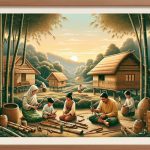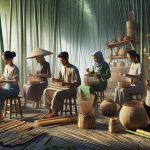I've always been fascinated by how integral bamboo is to the Philippines, shaping its culture, economy, and environment. Centuries ago, my Filipino ancestors were already using bamboo for building homes and crafting everyday items, showcasing real ingenuity. Today, bamboo still plays a huge role, from stabilizing the economy through exports to helping fight climate change by absorbing CO2. It's not just about tradition; this plant is part of sustainable development and innovations like earthquake-resistant materials. Everywhere you look, bamboo is there, making a big impact. There's so much more to learn about its versatile uses and benefits.
Table of Contents
Key Takeaways
- Bamboo is integral to Filipino culture, used in construction, crafts, and music.
- It promotes economic resilience by creating jobs and boosting exports.
- Bamboo plays a vital role in environmental sustainability by absorbing CO2 and preventing soil erosion.
- Fast-growing and renewable, bamboo provides quick economic returns and requires minimal upkeep.
- Innovations in bamboo usage include earthquake-resistant housing and sustainable energy solutions.
Historical Significance of Bamboo
Bamboo has been a cornerstone of Philippine culture for centuries, with its use in construction and crafts dating back to pre-colonial times. Its role as a construction material isn't just traditional; it's a testament to the ingenuity of Filipino ancestors who utilized bamboo's strength and flexibility to build everything from simple huts to intricate boats. This deep-rooted history highlights the importance of bamboo in shaping the economic and social landscapes of the Philippines.
Fast forward to today, and the bamboo industry continues to thrive. It's not just about maintaining cultural heritage; it's about economic resilience. The Philippine government recognized this potential early on, promoting bamboo as a sustainable alternative in the early 20th century. This initiative has paid off significantly. Thousands of Filipinos now work in the bamboo sector, crafting high-quality Philippine bamboo products that are admired and exported worldwide.
This global recognition isn't just a source of national pride; it's a major economic booster. The bamboo industry isn't just surviving; it's flourishing, proving that the importance of bamboo extends far beyond its historical roots. It's a lifeline for many, shaping modern industry while preserving a rich legacy.
Bamboo in Filipino Culture
Let's explore how deeply bamboo is woven into the fabric of Filipino culture. From the stilted bamboo housing of the iconic Bahay Kubo to the sleek designs of bamboo furniture, it's clear that bamboo isn't just a plant; it's a cornerstone of the Filipino way of life. The versatility of different bamboo species is showcased in every corner of a Filipino home, not just in construction but also in everyday objects like kitchen utensils and even the food we eat.
Bamboo's role extends beyond practical applications; it plays a pivotal part in Philippine arts. Bamboo instruments, such as the nose flute and the panpipes, are integral to the melodious expressions in Filipino festive celebrations and daily life. These instruments carry the soulful sounds of our ancestry and connect us to our past.
Moreover, initiatives like the National Greening Program highlight bamboo's significance in contemporary Filipino society, promoting its use for sustainable development and cultural preservation. Whether it's in the rhythmic clapping of bamboo poles in the Tinikling dance or the comforting walls of a village school, bamboo is undeniably central to Filipino cultural identity.
Environmental Impact of Bamboo
Turning to its environmental benefits, bamboo significantly reduces greenhouse gas emissions by absorbing up to 12 tons of carbon dioxide per hectare each year. This carbon dioxide absorption makes bamboo an excellent ally in our fight against climate change. Besides, its resilient roots play a crucial role in soil conservation. They hold the earth firmly, preventing erosion and maintaining fertile land for other plant life.
Bamboo also acts as a natural windbreaker. This trait enhances ecosystem stability by protecting smaller plants and animals from strong winds. Moreover, its dense foliage reduces light intensity, shielding the undergrowth from harsh ultraviolet rays, thus supporting a diverse habitat.
What's more, bamboo is a renewable resource that grows quickly and requires minimal care once established. This characteristic makes it a sustainable choice for both cultivation and propagation. Speaking of bamboo propagation, it's pretty straightforward. It doesn't need replanting, which saves labor and time, encouraging more widespread use and cultivation.
Here's a quick look in a table format at why bamboo is so beneficial:
| Benefit | Impact on Environment |
|---|---|
| Carbon Dioxide Absorption | Reduces greenhouse gases |
| Soil Conservation | Prevents erosion |
| Renewable Resource | Sustainable growth |
| Ecosystem Stability | Protects other plant life |
| Bamboo Propagation | Easy cultivation |
Economic Benefits of Bamboo
Exploring the economic benefits, we see that bamboo offers quick returns due to its fast growth cycle of just 3-5 years. This highly renewable resource isn't just fast; it's versatile too. Bamboo is used in a wide range of products like construction materials, furniture, and even food. This versatility means there's a steady demand for bamboo, both locally and internationally.
In the Philippines, we use bamboo to create various goods that are essential in everyday life but also have a significant economic impact. By exporting bamboo products, we can tap into international markets, boosting the country's economy. It's not just about selling abroad though; bamboo also helps to create jobs right here at home. From the farmers who grow it to the artisans who craft it, bamboo supports a whole community.
Moreover, as we develop new ways to use bamboo, we're not just increasing its economic value; we're also providing sustainable, eco-friendly alternatives to more traditional, often environmentally damaging materials. Every step forward in the bamboo industry is a step towards a more stable and prosperous future for all of us here. It's a win-win situation – good for our pockets and our planet!
Innovations in Bamboo Usage
Innovations in bamboo usage in the Philippines are transforming how we build and live sustainably. Bamboo's structural strength makes it ideal for earthquake-resistant housing. It's amazing to see how bamboo can be turned into homes that not only stand strong during tremors but also reduce our carbon footprint.
Using bamboo doesn't stop at building. The versatility of this material allows us to create complex products like bamboo fiber, revolutionizing fabrics and even everyday products. Imagine wearing clothes or using gadgets partly made from bamboo! Plus, bamboo residues aren't wasted—they're upcycled into charcoal, providing sustainable energy solutions for countless families, especially in rural areas.
Collaborations with countries like China are crucial. They help us enhance our bamboo sector, bringing in advanced technologies and more expertise. This isn't just about growth; it's about sustainable development that supports local livelihoods.
The range of bamboo species in the Philippines means a variety of products can be crafted. From Bamboo Musical instruments that capture the heart of our culture to everyday items in our homes, bamboo is truly a wonder material. Bamboo and Rattan together are paving the way for a greener future, proving that what we use to build and live today shapes our tomorrow.
Frequently Asked Questions
What Is the Contribution of Bamboo Crafts in the Philippines?
Bamboo crafts boost the Philippines' economy, providing jobs and preserving cultural heritage. They're eco-friendly and demonstrate the versatility and artistic skill of Filipino artisans, sustaining traditions and promoting sustainable practices.
What Is the Main Purpose of Bamboo?
I'd say bamboo's main purpose is its versatility. It's used for construction, crafts, and even food. Its rapid growth makes it a sustainable choice for these uses, benefiting both the environment and economy.
What Is the Symbol of Filipino Bamboo?
The symbol of Filipino bamboo is resilience, strength, and versatility. It reflects our adaptability and unity through its use in traditional ceremonies and everyday life, embodying growth and prosperity in our culture.
Is Bamboo Farming Profitable in the Philippines?
Yes, I've found bamboo farming quite profitable in the Philippines due to its high demand and fast growth. It's great for various products, boosting local economies and providing sustainable development opportunities.
- How Does Ring Spun Cotton Affect Garment Fit and Shape Retention? - August 13, 2024
- What Are the Challenges in Producing Ring Spun Cotton? - August 13, 2024
- Is Ring Spun Cotton Suitable for Plus-Size Clothing? - August 13, 2024







